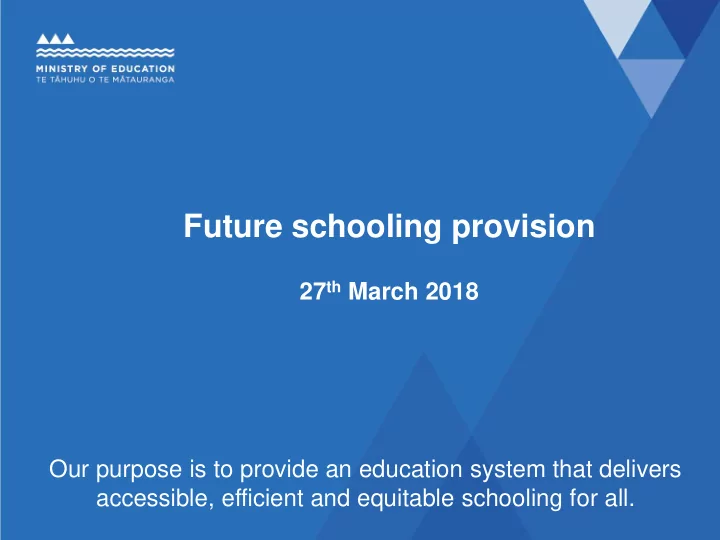

Future schooling provision 27 th March 2018 Our purpose is to provide an education system that delivers accessible, efficient and equitable schooling for all.
Session overview 1. Purpose/objectives 2. Current education landscape 3. Interactive session # 1 – Strengths and opportunities 4. Engagement phase 5. Interactive session # 2 – Inclusive engagement 6. What next? 2 education.govt.nz
Purpose of the Area Strategy Review In the context of medium and long-term population growth within the area …. 1) Whether the existing infrastructure can accommodate this growth; and 2) What school property requirements are needed to support a quality education network in the future. 3 education.govt.nz
Objectives of an Area Strategy Review Our purpose is to provide an education system that delivers: 1. accessible, 2. efficient and 3 equitable schooling for all. 4 education.govt.nz
Outcomes of today’s hui 1. Big picture view 2. Key contacts 3. Reference Group 5 education.govt.nz
Glossary • State schools - Most of the schools in New Zealand are owned and funded by the state. • State integrated - are state schools that provide education through their 'special character’ (such as specific teaching philosophy or religion). • Māori medium education – this is defined in this presentation as early childhood services and schools/kura where Te Reo Māori is taught more than 50% of the time. 6 education.govt.nz
Glossary • Capacity – defined by the Ministry as how many student places are available at a school. This differs from year to year based on the age of the students attending and is affected by the number of classrooms on site as well. • Enrolment Scheme – School enrolment zones stop schools from getting overcrowded, and give children who live in the school area (the zone) a guarantee that they can go to their local school. 7 education.govt.nz
Setting the scene Clive School 37 Early learning Haumoana School services Waimarama School 8 education.govt.nz
Havelock North Brookvale/Romanes Drive Iona/Havelock Hills 9 education.govt.nz
Current education provision 3 secondary 37 ECE providers 6 contributing 1 and 1 full intermediate primary 10 education.govt.nz
Early learning provision 11 education.govt.nz
Primary aged learners Total number of learners enrolled in state schools offering Year 1-8 education 2500 2400 No of students 2300 2200 2100 2000 2007 2008 2009 2010 2011 2012 2013 2014 2015 2016 2017 12 education.govt.nz
Primary aged learners (ethnicity) European / Pākehā 1950 1900 Much of the recent 1850 roll increase in the 1800 No. of students 1750 last 5 years has 1700 been attributed to 1650 not just European 1600 1550 but also other 1500 ethnicities 1450 2007 2008 2009 2010 2011 2012 2013 2014 2015 2016 2017 Māori/Pasifika Asian and Other Ethnicities 600 90 80 500 70 No. of students No. of students 60 400 50 300 40 30 200 20 10 100 0 0 2007 2008 2009 2010 2011 2012 2013 2014 2015 2016 2017 2007 2008 2009 2010 2011 2012 2013 2014 2015 2016 2017 Year Year Asian Other 13 education.govt.nz Māori Pasifika
Secondary aged learners Single sex education highly sought after 14 education.govt.nz
Dominant Pathways for learners (2016) 15 education.govt.nz
Māori & Pasifika learners 16 education.govt.nz
Future Roll Growth 3000 2500 2000 Total students 1500 1000 500 0 2013 2018 2023 2028 2033 2038 Year Primary (Medium) Primary (High) Secondary (Medium) Secondary (High) 17 education.govt.nz
Future Population Growth Percentage of population change for school aged children (2018-2028 ) 18 education.govt.nz
Interactive session # 1 Focus: Future proofing the network 1) What is working well? 2) Where are the opportunities for improvement? 19 education.govt.nz
Engagement Phase Gaining a greater understanding of the community’s needs and concerns. To ensure any changes to the schooling provision delivers better educational outcomes for all children. Formation of Reference Group to help formulate options based on community feedback. 20 education.govt.nz
Interactive session # 2 Focus: Inclusive engagement 1) How do we involve everyone with a stake in the education system? 2) Recommendations for composition of Reference Group 21 education.govt.nz
What next • Develop public webpage on Education.govt.nz • Reference Group formed with Terms of Reference agreed upon • Begin engagement with the community 22 education.govt.nz
Ministry of Education (Hawke’s Bay Region) points of contact HB Area Strategy Review HBArea.Strategy@education.govt.nz (live from 1 st April 2018) Kirsty Oosterkamp Kirsty.Oosterkamp@education.govt.nz Natasha Kiwara Natasha.Kiwara@education.govt.nz 23 education.govt.nz
Recommend
More recommend